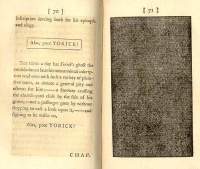Document
From The Art and Popular Culture Encyclopedia
| Revision as of 11:16, 11 April 2024 Jahsonic (Talk | contribs) ← Previous diff |
Current revision Jahsonic (Talk | contribs) |
||
| Line 1: | Line 1: | ||
| - | [[Image:Index Librorum Prohibitorum.jpg|thumb|200px|right|The ''[[Index Librorum Prohibitorum]]'' ("[[banned books|List of Prohibited Books]]") is a list of publications which the [[Catholic|Catholic Church]] [[censorship|censored]] for being a [[danger]] to itself and the faith of its members.]] | + | [[Image:Index Librorum Prohibitorum.jpg|thumb|200px|right|The ''[[Index Librorum Prohibitorum]]'' |
| - | + | ]] | |
| - | [[Image:The Death of Marat by Jacques-Louis David (1793).jpg|thumb|left|200px|''[[The Death of Marat]]'' ([[1793]]) by [[Jacques-Louis David]]]] | + | [[Image:The Death of Marat by Jacques-Louis David (1793).jpg|thumb|left|200px|''[[The Death of Marat]]'']] |
| [[Image:The black page in Tristram Shandy.jpg|thumb|right|200px|The [[black page]] in ''[[The Life and Opinions of Tristram Shandy, Gentleman]]'' (1759-1767)]] | [[Image:The black page in Tristram Shandy.jpg|thumb|right|200px|The [[black page]] in ''[[The Life and Opinions of Tristram Shandy, Gentleman]]'' (1759-1767)]] | ||
| {{Template}} | {{Template}} | ||
| - | A '''document''' is a [[writing|written]], [[drawing|drawn]], presented, or memorialized representation of thought, often the manifestation of [[nonfiction|non-fictional]], as well as [[fiction]]al, content. The word originates from the Latin ''{{Lang|la|Documentum}}'', which denotes a "teaching" or "lesson": the verb ''{{Lang|la|doceō}}'' denotes "to teach". In the past, the word was usually used to denote written proof useful as [[evidence]] of a truth or fact. In the [[computer age|Computer Age]], "document" usually denotes a primarily textual [[computer file]], including its structure and format, e.g. fonts, colors, and [[Computer-generated imagery|images]]. Contemporarily, "document" is not defined by its [[transmission medium]], e.g., paper, given the existence of [[electronic document]]s. "Documentation" is distinct because it has more denotations than "document". Documents are also distinguished from "[[Realia (library science)|realia]]", which are three-dimensional objects that would otherwise satisfy the definition of "document" because they memorialize or represent thought; documents are considered more as two-dimensional representations. While documents can have large varieties of customization, all documents can be shared freely and have the right to do so, creativity can be represented by documents, also. History, events, examples, opinions, etc. all can be expressed in documents. | + | A '''document''' is a [[writing|written]], [[drawing|drawn]], [[presented]], or [[memorialized]] [[representation]] of [[thought]], often the manifestation of [[nonfiction|non-fictional]], as well as [[fiction]]al, content. The word originates from the Latin ''documentum'', which denotes a "teaching" or "lesson": the verb ''doceō'' denotes "to teach". In the past, the word was usually used to denote written proof useful as [[evidence]] of a truth or fact. In the [[computer age|Computer Age]], "document" usually denotes a primarily textual [[computer file]], including its structure and format, e.g. fonts, colors, and [[Computer-generated imagery|images]]. Contemporarily, "document" is not defined by its [[transmission medium]], e.g., paper, given the existence of [[electronic document]]s. "Documentation" is distinct because it has more denotations than "document". Documents are also distinguished from "[[Realia (library science)|realia]]", which are three-dimensional objects that would otherwise satisfy the definition of "document" because they memorialize or represent thought; documents are considered more as two-dimensional representations. While documents can have large varieties of customization, all documents can be shared freely and have the right to do so, creativity can be represented by documents, also. History, events, examples, opinions, etc. all can be expressed in documents. |
| ==See also== | ==See also== | ||
| Related concepts: | Related concepts: | ||
Current revision
|
Related e |
|
Featured: |
A document is a written, drawn, presented, or memorialized representation of thought, often the manifestation of non-fictional, as well as fictional, content. The word originates from the Latin documentum, which denotes a "teaching" or "lesson": the verb doceō denotes "to teach". In the past, the word was usually used to denote written proof useful as evidence of a truth or fact. In the Computer Age, "document" usually denotes a primarily textual computer file, including its structure and format, e.g. fonts, colors, and images. Contemporarily, "document" is not defined by its transmission medium, e.g., paper, given the existence of electronic documents. "Documentation" is distinct because it has more denotations than "document". Documents are also distinguished from "realia", which are three-dimensional objects that would otherwise satisfy the definition of "document" because they memorialize or represent thought; documents are considered more as two-dimensional representations. While documents can have large varieties of customization, all documents can be shared freely and have the right to do so, creativity can be represented by documents, also. History, events, examples, opinions, etc. all can be expressed in documents.
See also
Related concepts:
- Data storage device: to store documents.
- Media type: document parts (text block, illustration, audio sample, etc.) can use different media types to store and "display" it.
- Internet of Things
- Realia (library science)
- Subject (documents)
Other related articles:
- Historical document
- Desktop publishing
- Word processor
- Documentary
- Documentary film
- Documentation science

.jpg)


